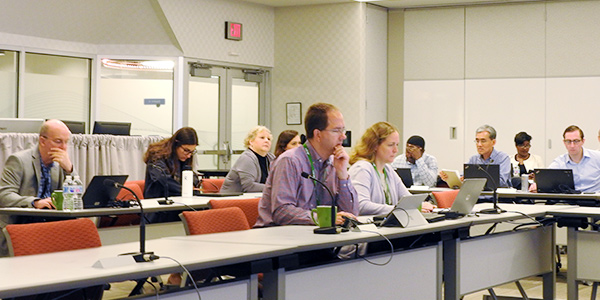VALLEY FORGE, Pa. — PJM staff agreed on Tuesday to delay approval of revisions to generation outage procedures after stakeholders raised concerns over potential market consequences.
Bob O’Connell, director of regulatory affairs and compliance for Panda Power Funds, pressed the Operating Committee to defer a vote on changes to Manual 10, saying the proposed language would encourage resource owners to distort prices in their favor.
Vince Stefanowicz, PJM senior lead engineer, said the manual specifies that generators must submit outage requests corresponding to the time frame that they will be unavailable because of a transmission facility outage — and, under the proposed language, in the event of a PJM-identified stability limitation.
O’Connell said PJM’s decision to remove supply from the market to address stability constraints will result in some units committing at price-based offers, rather than cost. Under PJM’s rules, only the affected generator would know of the constraint, O’Connell said, therefore gaining a competitive advantage over other units and possibly incorporating greater mark-ups into their offers.
As a solution, O’Connell suggested PJM implement a closed-loop interface around the affected resource that restricts the output to below the stated stability limit — and it must be used in each of the markets. He also encouraged the RTO to publicize stability limits on OASIS prior to contacting the affected generator.
“I think Bob has raised a legitimate issue,” said Mike Bryson, PJM’s vice president of operations. “But we have an interim issue that this practice will be enforced until we come up with a solution. I don’t know how to resolve that outside a clarification in the manual.”
The committee agreed to delay the revisions — and remove stability-related changes from Manual 3 revisions that were approved earlier in the meeting — until the issue is resolved.
O’Connell said he will present a problem statement and issue charge at the June meeting of the Market Implementation Committee detailing his proposed solution.
BTM Solar Penetration Mimicking CAISO Duck Curve
Increasing penetration of behind-the-meter solar generation creates a dramatic load shape in certain PJM zones during spring and fall months, mimicking CAISO’s infamous “duck curve,” staff said Tuesday.
Joseph Mulhern, PJM senior engineer, told the OC that significant growth in both grid-connected and BTM solar units over the last decade have caused load forecasting challenges, particularly during shoulder seasons when reduced electricity demand results in overgeneration.
“Since the duck curve became a popular concept … do we see anything reminiscent of this?” Mulhern said. “If you look in the right places at the right times, we do.”
CAISO first introduced the idea of the duck curve in 2013 to illustrate how rapidly expanding solar generation was impacting the system. Solar energy often peaks midday when electricity usage, particularly in the spring, may be lower than usual. The resulting curve resembles a duck — hence the name — which has become common nomenclature when describing the challenges of harnessing the full potential of solar generation. (See Report: Calif. ‘Duck Curve’ Growing Faster than Expected.)
Mulhern presented sample load shapes from 24-hour periods in March — the peak season for the duck curve in PJM —and said traditional forecasting methods failed to capture all of the 3,304 MW of BTM solar currently online. The RTO can’t access unit-specific data for BTM generation like it can for the more than 1,500 MW of grid-connected solar panels, so staff has implemented a “reconstituted load” calculation to fill in the gaps.
The reconstituted load “retrains” the existing model by adding historic measured load and estimated BTM generation together. Staff then subtract forecasted BTM generation to get a more accurate picture of how solar impacts load shape — but it’s not exact.
“All of this is evidence that our load forecasting process needs to have some changes made beyond our traditional approach,” Mulhern said.
Staff will continue educating the OC about existing BTM business rules over the course of several months before suggesting manual revisions to better account for the grid’s diversifying resource mix.
Quad Cities RAS Unnecessary
Exelon said recent analysis from PJM and Commonwealth Edison determined a remedial action scheme (RAS) in the Quad Cities region of Illinois and Iowa is no longer necessary to meet planning criteria.
The Quad Cities RAS prevents instability for a three-phase fault during line outages and thermal overloads during multiple line outages. Exelon said incremental grid reinforcements reduced the need for the scheme. The company will disable the RAS by the end of year with complete removal in 2020.
Manuals Endorsed
- The committee unanimously endorsed the following manual changes:
- Manual 1: Periodic cover-to-cover review to update terminology and guidelines for control center and data exchange requirements.
- Manual 3: Biannual review to update transmission operating procedures, excluding references to stability.
- Manuals 11 and 13: Clarifies the impact of operationalizing gas contingencies on reserve requirements and reserve market eligibility.
- Manual 13: Periodic cover-to-cover review and changes to align with new Markets Gateway functionality for resource-limitation reporting to be implemented July 1.
- Manual 36: Annual update requirement.
Stakeholders also approved an annual review of the OC’s charter.
– Christen Smith








